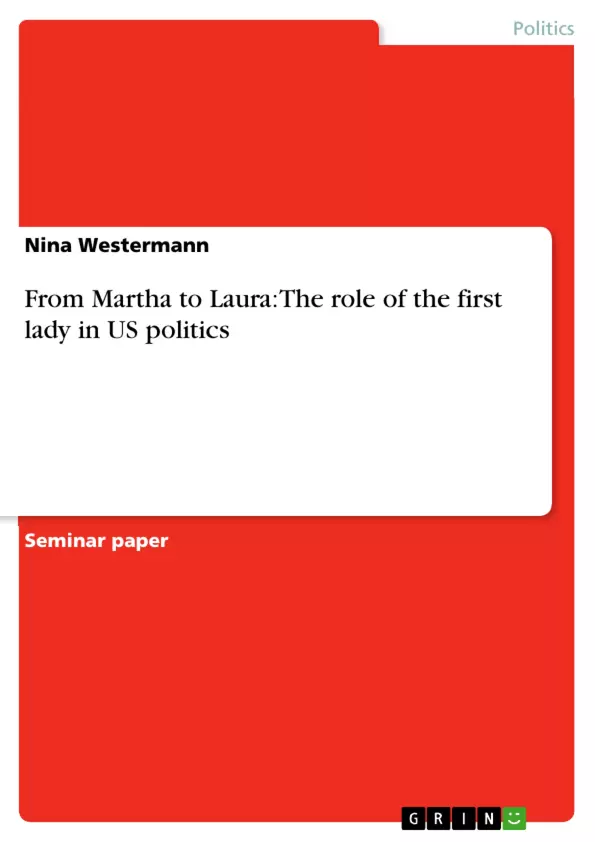The position of the first lady of the United States is unequalled anywhere. In comparison to the wives of other democratically elected leaders, she has a much larger staff, receives immense public attention and is in charge of a considerable amount of federal money. While in Great Britain for example, public attention focuses on the members of the royal family and not on the prime minister’s wife, the American first lady was drawn to a public role from the very beginning of the United States of America on.
While upon inauguration, the president of the United States swears to preserve, protect and defend the Constitution, what does his wife, the first lady promise? The president might be limited by party issues and political ties, but which factors influence the first lady in fulfilling her position? The U.S. Constitution is silent on the role of the spouse of the president since “after all, there is only one person that chooses her”1(and maybe someday him). The first lady therefore has no democratic legitimacy, but this has not stopped her from publicly representing the American Nation. Where does the acceptance of the first lady as a spokesperson for the American people come from? These are some of the questions this paper will try to answer. The main attention will focus on possible political weight and/or authority of the first lady.
The first part will give an overview over the historical development of the office from 1789 until today, describing important social, political and historical factors which have influenced this process as well as personal influences the first ladies and their husbands have had on their position. The second part will focus on the specific roles that the first ladies have taken over throughout its history and their effect on American politics. Although the early first ladies and their influence on the office will be considered too, the focal point will be on the modern first ladies of the 20thand 21st century.
Concerning the spelling of First Lady this paper uses the form of leading first ladies’ scholars like Robert P. Watson and use the lower case except when referring directly to a specific first lady.
Inhaltsverzeichnis (Table of Contents)
- Introduction
- 1. History of the office of the First Lady
- 1.1. Internal Influences
- 1.2. External Influences
- 1.2.1. Constitutional outlines
- 1.2.2. Public Expectation
- 1.2.3. History and Custom
- 2. Official Duties
- 2.1. Social Duties
- 2.1.1. Private Partner
- 2.1.2. White House Manager and Hostess
- 2.1.3. Role model
- 2.1.4. Social advocate
- 2.2. Political Duties
- 2.2.1. Presidential Adviser and Public Partner
- 2.2.2. Campaigner and Spokesperson
- 2.2.3. Diplomat
- 2.1. Social Duties
- Conclusion
Zielsetzung und Themenschwerpunkte (Objectives and Key Themes)
This paper explores the historical development and current roles of the First Lady of the United States. The paper aims to analyze the evolution of the office, taking into account both internal and external factors that have influenced its shape. It examines how the first ladies' personal views and the presidents' expectations have shaped the office, as well as how constitutional outlines, public expectations, and historical precedents have played a role.
- The historical evolution of the office of the First Lady
- The influence of presidents and their wives on the First Lady's role
- The impact of societal expectations and historical precedents on the First Lady's position
- The specific social and political duties undertaken by First Ladies throughout history
- The modern first ladies of the 20th and 21st century and their influence on American politics
Zusammenfassung der Kapitel (Chapter Summaries)
The first chapter delves into the historical development of the First Lady's office, starting from its inception in 1789. It examines how internal influences, like the personal views of presidents and their wives, and external factors, such as constitutional outlines, public expectations, and historical precedents, have shaped the role of the First Lady. Notable examples, such as Abigail Adams and Eleanor Roosevelt, are used to illustrate the different approaches and impacts First Ladies have had over time.
The second chapter explores the specific duties undertaken by First Ladies throughout history. It focuses on both social and political roles, outlining responsibilities ranging from hosting state dinners and acting as a role model, to advising the president and engaging in public campaigns. The chapter discusses how these roles have evolved and their impact on American politics.
Schlüsselwörter (Keywords)
This paper focuses on the historical development and contemporary roles of the First Lady of the United States, exploring key themes such as internal and external influences, social and political duties, and the evolving expectations of the office. It analyzes the perspectives of prominent First Ladies like Abigail Adams, Eleanor Roosevelt, and Hillary Rodham Clinton, providing insight into their unique contributions and the broader context of the First Lady's position in American politics.
- Citar trabajo
- Nina Westermann (Autor), 2004, From Martha to Laura: The role of the first lady in US politics, Múnich, GRIN Verlag, https://www.grin.com/document/65102



